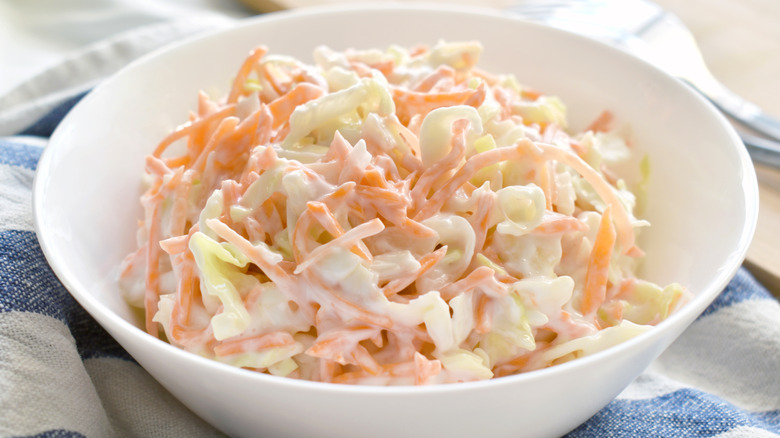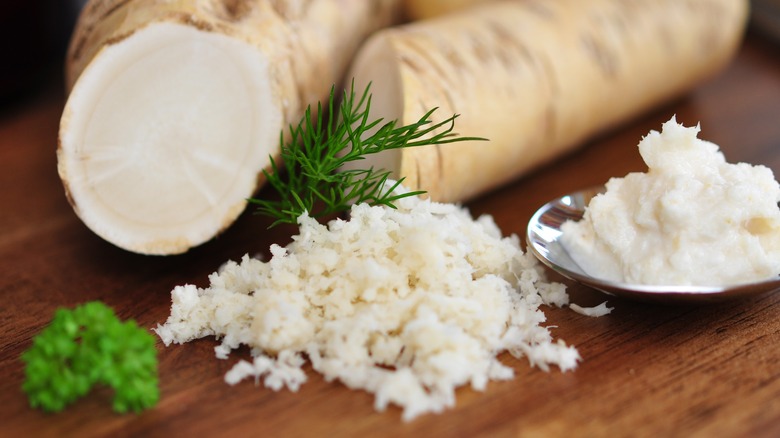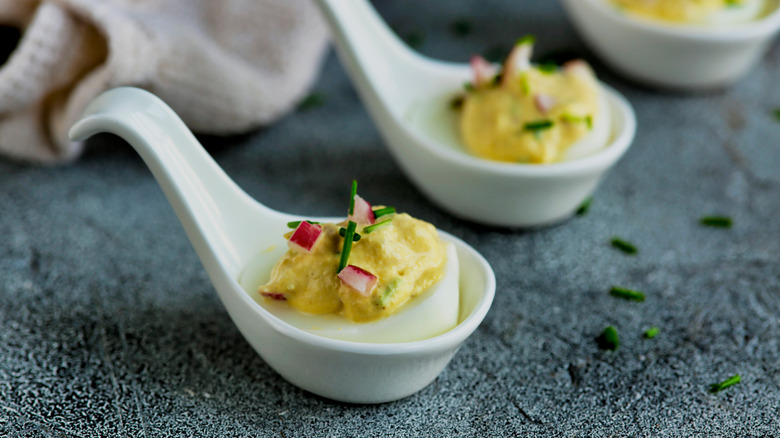The Bold Ingredient That Adds A Good Kick To Regular Coleslaw
When it comes to simple yet delicious side dishes, a hearty bowl of coleslaw can be a great pick. This dish is easy to make at home, as it's typically a simple combination of a creamy coleslaw dressing, carrots, and a mix of green and red cabbage.
A traditional take on coleslaw can certainly taste terrific, but if you want to give this popular side dish a bold upgrade, one easy way to do so is to add a bit of horseradish. Horseradish is a root in the same family as mustard and wasabi. It has a strong, pungent flavor, and when included in your coleslaw, horseradish adds a noticeable punch and dimension to the dish. Plus, a reasonable amount won't overpower your coleslaw's other flavors since the creamy dressing can balance the kick of horseradish.
Of course, if you're going to try out this suggestion, there are a couple of considerations to keep in mind so that your coleslaw ends up with the perfect amount of bite and is not overwhelmed by the horseradish.
Coleslaw (hearts) horseradish
One of the first considerations when adding horseradish to your coleslaw is whether to use fresh or prepared horseradish. If you opt to use fresh horseradish, that means simply grating the root directly into your dish. The prepared variety, sold in jars often found in a supermarket's condiments aisle, is typically a combination of horseradish and vinegar that can include other add-ins such as oils, spices, and even mustard. Prepared horseradish is not the same as horseradish sauce, which is raw or prepared horseradish mixed with a creamy base such as sour cream or mayonnaise. Because most coleslaw sauce already has a creamy base, there's no real benefit to adding horseradish sauce to your coleslaw. Instead, prepared or freshly grated is better in this application.
Another consideration is how much horseradish to add. Generally, recommended amounts range between 1 and 3 tablespoons of prepared horseradish to your recipe. If you're using a fresh root, you should know that fresh horseradish tends to be much stronger and spicier than prepared versions, meaning you should use about half the amount of freshly grated as prepared. If you're unsure of your tolerance for horseradish, it's best to start with less and slowly add more until you reach your preferred level of spiciness. If you accidentally add too much horseradish, you can balance it with a bit of extra sour cream or mayo in your coleslaw dressing.
Horseradish dishes and kicky alternatives
If you love spicy food but aren't a fan of the pungent taste of horseradish, there are other ways to give your slaw a flavorful lift. Red hot sauces such as sriracha or Cholula are two good options. Not only would they provide a pepper-powered punch, but the bright color of these sauces can also elevate your slaw by giving it a colorful appearance as well as a unique flavor. Or, skip pepper sauces altogether and use a dash of crushed red pepper flakes or cayenne pepper to give coleslaw a blaze of heat. Although these alternatives won't have the pungency of horseradish, they can provide a bit of burn. Another method for building some fire in your coleslaw is to chop up and toss in pickled jalapeño peppers. Ramp up the flavor even more by including a bit of the brine.
For those who love the idea of adding horseradish to recipes that you might consider too mild, going beyond coleslaw is encouraged. For instance, adding a bit of horseradish to your deviled eggs can give them more depth of flavor and a noticeable punch. Or, mix horseradish into your mashed potatoes for another creamy, spicy side dish. Incorporating horseradish into dips like hummus or a homemade horseradish and dill dip creates an unexpected treat. Start with coleslaw, and you might find that however you choose to use it, horseradish can provide the flavor kick that's missing in many of your favorite sides.


